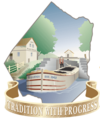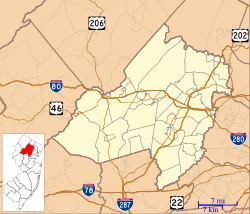Wharton, New Jersey facts for kids
Quick facts for kids
Wharton, New Jersey
|
||
|---|---|---|
|
Borough
|
||

St. Mary's Church, listed on the National Register of Historic Places
|
||
|
||
| Motto(s):
Tradition with Progress!
|
||
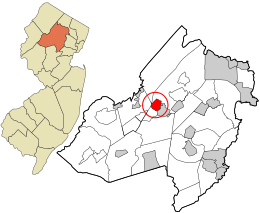
Location in Morris County and the state of New Jersey.
|
||
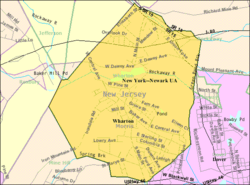
Census Bureau map of Wharton, New Jersey
|
||
| Country | ||
| State | ||
| County | ||
| Incorporated | June 26, 1895 as Port Oram | |
| Renamed | April 16, 1902 as Wharton | |
| Named for | Joseph Wharton | |
| Government | ||
| • Type | Borough | |
| • Body | Borough Council | |
| Area | ||
| • Total | 2.14 sq mi (5.53 km2) | |
| • Land | 2.08 sq mi (5.38 km2) | |
| • Water | 0.06 sq mi (0.15 km2) 2.63% | |
| Area rank | 399th of 565 in state 33rd of 39 in county |
|
| Elevation | 666 ft (203 m) | |
| Population
(2020)
|
||
| • Total | 7,241 | |
| • Estimate
(2023)
|
7,346 | |
| • Rank | 314th of 565 in state 26th of 39 in county |
|
| • Density | 3,494.7/sq mi (1,349.3/km2) | |
| • Density rank | 194th of 565 in state 9th of 39 in county |
|
| Time zone | UTC−05:00 (Eastern (EST)) | |
| • Summer (DST) | UTC−04:00 (Eastern (EDT)) | |
| ZIP Code |
07885
|
|
| Area code(s) | 973 | |
| FIPS code | 3402780390 | |
| GNIS feature ID | 0885443 | |
Wharton is a small town, called a borough, located in Morris County, in the state of New Jersey. In 2020, about 7,241 people lived here. This was an increase of over 700 people since 2010!
Wharton was first created on June 26, 1895. Back then, it was called Port Oram. This new borough was formed from parts of Randolph Township and Rockaway Township. The name was changed to Wharton on April 16, 1902. It was named after Joseph Wharton, who owned the Wharton Steel Company.
Contents
History of Wharton
In 1831, the Morris Canal was finished. This canal connected Newark to Phillipsburg, New Jersey. It passed through towns like Dover and Port Oram (which is now Wharton). The canal was important for moving iron ore and other products from Morris County. Its main job was to transport coal from Pennsylvania mines to the coast.
On June 28, 1895, people from several small communities, including Port Oram, voted to become one borough. They chose the name Port Oram because it was the largest community. The new borough was about 2.25 square miles. Voters elected a mayor and council members to lead the new town. These leaders were often mine managers, store owners, or teachers.
The borough was renamed in 1902 to honor Joseph Wharton. He was born in 1826 in Philadelphia. Joseph Wharton became a very successful businessman. He started by making zinc and nickel. Over time, he bought a lot of shares in Bethlehem Iron Works. He also bought parts of railroads that carried coal and iron. He even bought iron mines and furnaces near Port Oram. Joseph Wharton was also known for starting the Wharton School at the University of Pennsylvania. The town was named after him in a public vote in 1902.
In 1984, parts of Wharton were used as filming locations. The famous singer Cyndi Lauper filmed her music video "Time After Time" in the borough.
Geography and Climate
Wharton covers a total area of about 2.13 square miles (5.51 square kilometers). Most of this area is land, with a small amount of water.
Wharton shares its borders with several other towns in Morris County. These include Dover, Jefferson Township, Mine Hill Township, Rockaway Township, and Roxbury Township.
Some smaller communities within Wharton are Irondale, Luxemburg, Maryville, Mount Pleasant, and Port Oram.
Climate in Wharton
The weather in Wharton has hot, humid summers. Winters are usually mild to cool. This type of weather is known as a humid subtropical climate.
Population Information
| Historical population | |||
|---|---|---|---|
| Census | Pop. | %± | |
| 1890 | 775 | — | |
| 1900 | 2,069 | 167.0% | |
| 1910 | 2,983 | 44.2% | |
| 1920 | 2,877 | −3.6% | |
| 1930 | 3,683 | 28.0% | |
| 1940 | 3,854 | 4.6% | |
| 1950 | 3,853 | 0.0% | |
| 1960 | 5,006 | 29.9% | |
| 1970 | 5,535 | 10.6% | |
| 1980 | 5,485 | −0.9% | |
| 1990 | 5,405 | −1.5% | |
| 2000 | 6,298 | 16.5% | |
| 2010 | 6,522 | 3.6% | |
| 2020 | 7,241 | 11.0% | |
| 2023 (est.) | 7,346 | 12.6% | |
| Population sources: 1890 1900–1920 1900–1910 1910–1930 1940–2000 2000 2010 2020 |
|||
The 2010 United States census counted 6,522 people living in Wharton. There were 2,304 households, which are groups of people living together. The population density was about 3,039 people per square mile.
About 23.9% of the people living in Wharton were under 18 years old. The average age of people in Wharton was 38.2 years.
Parks and Recreation
The Hugh Force Canal Park is a great place for outdoor activities. It has hiking trails that follow the path of the old Morris Canal and old railroad lines. You can also see Lock 2 East of the canal there.
Education in Wharton
The Wharton Borough School District serves students from kindergarten through eighth grade. The district has two schools. As of the 2018–19 school year, there were 738 students.
- Marie V. Duffy Elementary School: This school has 462 students in grades K–5.
- Alfred C. MacKinnon Middle School: This school has 271 students in grades 6–8.
Students in ninth through twelfth grades attend Morris Hills High School. This high school is located in Rockaway Borough. It also serves students from parts of Rockaway Borough and Rockaway Township.
Transportation
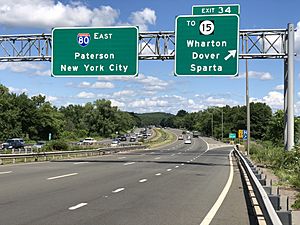
As of 2010, Wharton had over 22 miles of roads. Most of these roads are maintained by the borough itself.
Major highways that pass through Wharton include Interstate 80 and New Jersey Route 15.
Public Transportation
NJ Transit provides local bus service in Wharton. You can catch the 880 bus route to get around.
Notable People from Wharton
Many interesting people have lived in or are connected to Wharton:
- Kirk Alyn (1910–1999): He was the first actor to play Superman on screen. He lived in Wharton when he was young.
- Alan Rowe Kelly (born 1959): He is an independent film actor, director, writer, and producer. He often works on horror films.
- Mayme Schweble (1874–1943): She was a prospector and politician. She served in the Nevada Assembly from 1924 to 1926.
See also
 In Spanish: Wharton (Nueva Jersey) para niños
In Spanish: Wharton (Nueva Jersey) para niños


